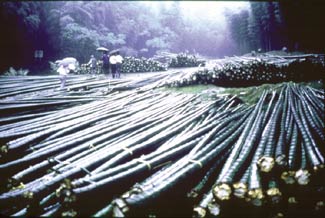A Writer-Contractor Explores the New World of Grass Flooring
BY THOMAS WILMER
Susan, one of my remodel clients, announced that she wanted me to install a bamboo floor in her Cayucos beach house. I thought it was to be another one of her inventive, out-of-the-box ideas that always bring a smile to my face as she innocently explains her theories and concepts.
I immediately visualized a very funky floor of wobbly half-round bamboo strips where one could easily lose balance and forever lose any food crumbs and scraps that happened to land on the floor.
When Susan arrived on the job with boxed bundles stamped with a Plyboo brand label, I was surprised (and relieved) to discover that the bamboo flooring had been milled and shaped to exactly the same dimensions as a typical North American oak or maple hardwood strip-flooring–relatively short-length strips, three and half inches wide.
And while it’s not yet common, Susan isn’t alone in being a bamboo convert; a whole subdivision in Paso Robles is being built with Plyboo floors, saving scores of trees from the millhouse.
Still, whenever I read about a product that's touted as a PC-eco-green product, I always wonder if the claims are legitimate–especially in light of recent revelations about panda habitats being destroyed through the indiscriminate destruction of Asian bamboo forests.
Curious to know if Plyboo's Chinese bamboo fields are harvested and maintained in a responsible manner, I contacted Ron Caso at Plyboo of America's corporate offices and put the question directly to him.
His response, I thought, was thoughtful and honest: "The only way to really prove that bamboo is harvested in controlled forests is to have a basic understanding of the culture in China. The political climate as well as the reverence for the bamboo plant is enough to give one a good idea of what their mentality is.
"Two thousand or more years of harvesting this remarkable plant for food, building material, weapons, and transportation makes you stop and think: Will these people waste this most valuable resource in their country for the benefit of a few? No, I think not.
"There are some concerns over harvest, but the government keeps a watchful eye on it, and hopefully the supply will never end with proper management and by the oversight of the Subtropical Forestry Research Institute of China. These are my thoughts on the subject, but I realize man has been known to soil his own house for centuries!"
Traditional oak-flooring is full-thickness stock, whereas the Plyboo product Susan selected is laminated. A series of strips (each about a half-inch wide) are glued and pressure-laminated horizontally as well as vertically in three sandwiched layers (like plywood–thus the genesis of its name), then surfaced and edged with tongue-and-groove joints.
The process of laying the floor is exactly the same as traditional oak flooring. The manufacturer of Plyboo recommends standard blind-nailing and/or glue, depending upon the subfloor conditions.
I was most impressed with Plyboo's radiant golden-toned beauty–complete with random accents from the bamboo’s natural growth "nodes" or joints. Additionally, the product came prefinished, so once the boards went down, the job was done, short of reinstalling the baseboards and thresholds.
Plyboo is also available unfinished, allowing consumers to custom tint and finish the floor to their exact specifications.
Sometimes strip-flooring arrives on the job with more than a few warped, bowed, or twisted boards, and this can add much time and aggravation as you are forced to wrestle each reluctant board into place.
The nearly total absence of twisted or bowed planks was another impressive quality of the Plyboo product we installed. It was refreshingly uniform, straight and smooth, and I rarely had to "persuade" a board to fit.
I instinctively want to call the bamboo flooring a "hardwood," as it is incredibly tough and dent resistant. Actually bamboo is not a wood at all; it's a grass. It is also the fastest-growing plant in the world and reaches full maturity in from five to seven years. Bamboo's prolific ability to perpetually propagate offshoots and pups makes it an ideal sustainable-yield "green" jungle-forest product.
Bamboo flooring is a cost-effective, extremely durable, long-life floor. Susan paid approximately $4.50 per square foot, prefinished, excluding labor and supplies.
Plyboo's products have been installed in thousands of homes around the world as well as government buildings, museums, gymnasiums, sport facilities, and offices, including BMW's corporate offices in Germany.
Plyboo is available with or without tongue and groove, finished and unfinished. The company also manufactures an extensive line of moldings and bamboo ceiling panels. Æ
Freelance writer Thomas Wilmer is a Morro Bay-based licensed general contractor specializing in custom remodels and is a professional member of the International Conference of Building Officials.